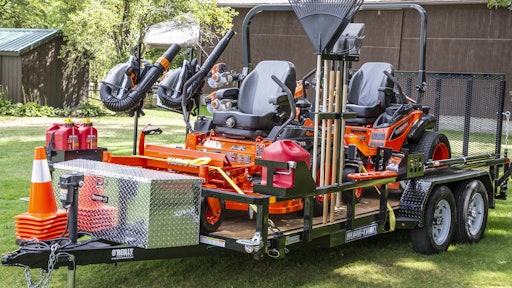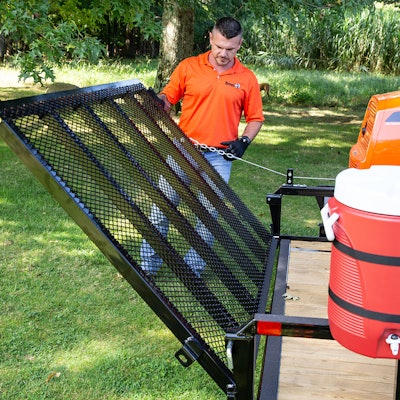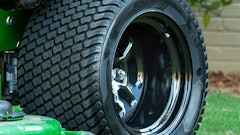
An organized, well-maintained trailer is vital for a landscaping business to thrive. A cluttered and disorganized trailer not only comes across as unprofessional, but it can also impede productivity.
By taking the time to properly prepare your trailer for a day’s worth of work, your crew’s safety and efficiency are prioritized. Establishing a consistent and repeatable process for tool and equipment storage allows the crew to complete one job, pack up everything and move on to the next one without misplacing items or wasting valuable time. Here are seven steps to implementing an orderly trailer this spring and summer.
1. Clean the trailer
Before you begin organizing your trailer, clear out all of its contents. This offers a blank slate to start from. Not to mention, an empty trailer is easier to clean and repair. Sweep the bed, inflate the tires and test the mechanical components’ functionality.
Another item to consider: does your trailer’s ramp have a spring assist? The ramp can be quite heavy to lift and lower manually, especially when transporting larger equipment such as lawn mowers. A spring assist can streamline the loading and unloading process, keeping your crew safe and feeling fresh.
2. Categorize equipment
After emptying the trailer, categorize items by type (hand tools, power tools, mowers, etc.). Think of this as taking inventory of all the trailer’s stored items. This strategy will help determine the ideal storage location for each category. It’s typical to lose track of what’s kept on the trailer, and items are more likely to be misplaced without adequate planning and categorization.
 A spring assist ramp can streamline loading and unloading and help keep crews safe.Buyers Products
A spring assist ramp can streamline loading and unloading and help keep crews safe.Buyers Products
3. Choose appropriate storage solutions
Efficient storage is a crucial factor in maintaining an organized trailer. Proper storage solutions, such as racks or hangers for long-handled tools, bins or drawers for sharp or handheld tools and shelving for larger equipment, maximize the trailer’s functionality. Additionally, ensure fuel cans are secured in storage areas that are readily accessible from all sides of the trailer.
It’s also critical to implement theft prevention measures for valuable tools. Use padlocks where necessary, as they keep items securely locked when not in use. Protecting your equipment ensures that you don’t have to stop working to replace any stolen items, keeping you and your crew on schedule.
4. Create a layout plan
Consider the sizes and shapes of your equipment when developing an effective layout for the trailer. For safety purposes, the heaviest items should be stored at ground level. When designing the layout plan, make sure that the floor remains clear to allow unobstructed access to all contents. Consider installing spare tire carriers on the outside of the trailer for ease of access. Doing so also ensures that they do not obstruct the load space.
5. Label everything
Labeling everything inside the trailer improves your crew’s ability to locate items. Use a labeling system that works for everyone, such as color coding. Keep a clipboard checklist in your truck for reference.
6. Secure loose items
Use bungee cords, tie-down straps or other methods to secure loose items and prevent any shifting during transport. This will minimize damage to your equipment in between jobs, keeping items in designated storage locations. Additionally, a tongue-style box designed for the front of your A-Frame trailer is great for weatherproof storage of miscellaneous items such as extra pairs of clothes or shoes.
7. Regularly maintain and reorganize
To ensure that your trailer is always in good working condition, regularly maintain and reorganize it. Working conditions and habits may change over time, so it’s important to keep that in mind when organizing the trailer to fit your workflow. Cleaning the trailer regularly allows you to replace damaged storage solutions in a timely manner, while also giving you the chance to address any deficiencies in the current layout plan.
Implementing these seven steps will improve the productivity, safety and efficiency of you and your crew. By instilling appropriate storage solutions and by securing loose items, tripping hazards are limited. Categorizing and labeling equipment minimizes the time spent searching for items, allowing for more time to be spent on the job. An organized trailer also creates a positive impression on your customers and opens doors for new business opportunities. The countless benefits are sure to make a lasting impact this spring and summer.




























